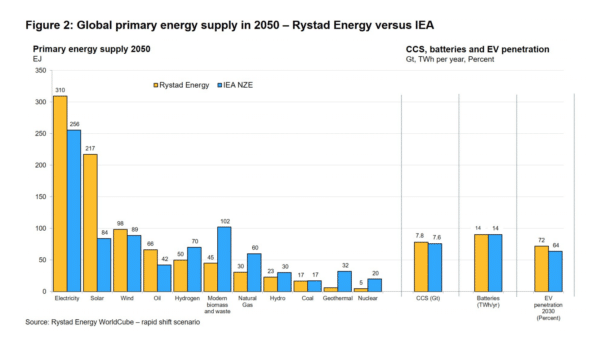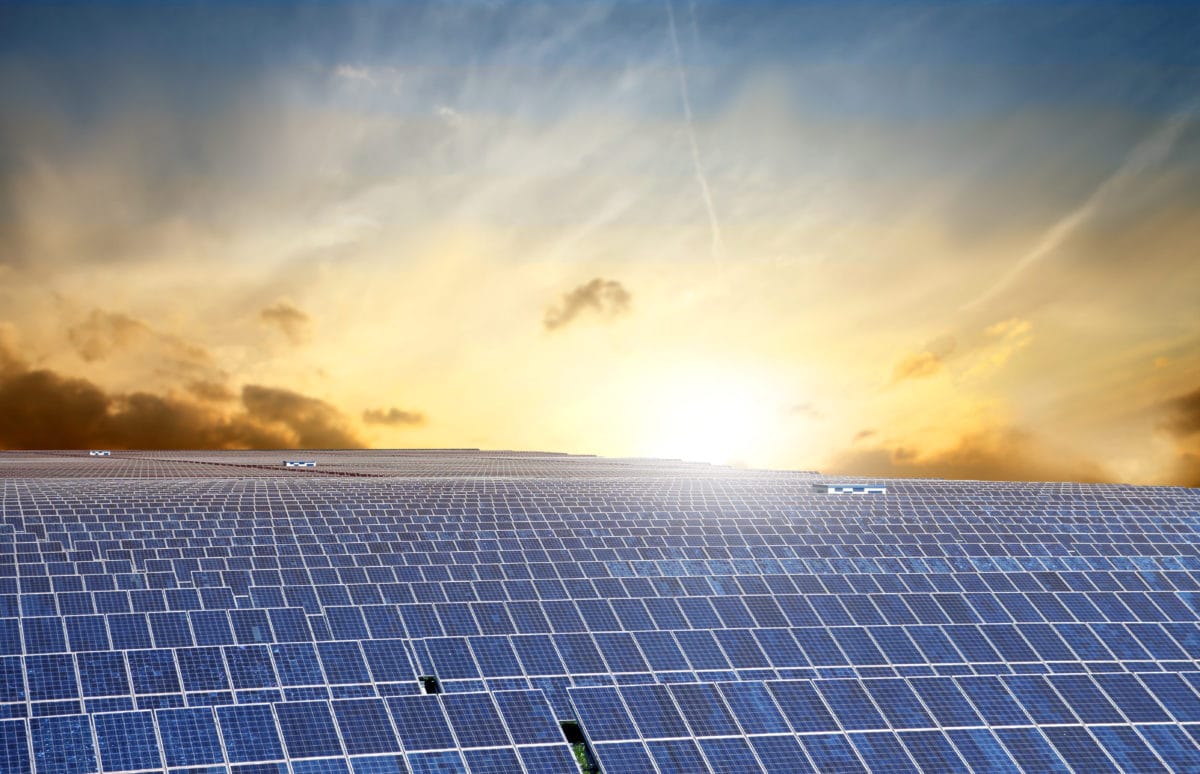On 18 May the International Energy Agency released the first global Net Zero by 2050 roadmap, which was requested by the UK Government’s COP26 leadership in advance of the UN Climate Change Framework Convention in Glasgow in November. The comprehensive 224-page report anticipates that solar will deliver 23,000 TWh of the 71,000 TWh forecast electricity generation needed by 2050, becoming the world’s single largest source of total energy supply.
Rystad Energy’s own global analysis was delivered before the IEA’s Roadmap for the Global Energy Sector, at its live streamed seven-hour Energy Transition Marathon on 6 May, and therefore was not influenced by it, and does not represent a rebuttal — more a genuine opportunity for comparison of the assumptions and methodologies of the two landmark studies.
In just such a comparison, released last Thursday, Rystad describes itself as “much more bullish on the rise of solar PV capacity” than the IEA, predicting more than twice as much solar, or 50,000 TWh, should be installed by 2050, on the basis that “the world needs to grow its power generation capacity further in order to fulfil electrification goals in buildings, transportation and industry and solar PV is the cheapest and most convenient way”.
Only two weeks ago at the Smart Energy Conference in Sydney, solar guru, Professor Martin Green who made the University of New South Wales a global hub of solar efficiency development, confidently asserted that by 2023 solar generation “should be at 10 cents a watt” becoming the cheapest form of energy the world has ever known.
The IEA and Rystad Energy predict that wind and solar will collectively grow to make up around 70% of primary energy by 2050, with wind generation contributing 20,000 TWh by 2042.
Solar outstrips biofuels on cost
While the IEA sees emerging renewables, such as biomass, geothermal, concentrated solar and marine energy, growing to 5,600 TWh of capacity by 2050, Rystad Energy predicts they will only achieve around 1,900 TWh, because they’ll be simply eclipsed by the cost competitiveness of solar — which will naturally grow solar’s piece of the pie.
“In our model, solar PV with batteries will be preferred ahead of expensive and inflexible sources like nuclear, biomass and geothermal,” says the Rystad comparison. It calculates that the cost of growing energy production capacity by 3,000 GW from 2030 to 2050 by deploying a combination of nuclear, biomass, geothermal, marine and hydro power — as posited by the IEA — would cost US$5-8 trillion, whereas “getting the same capacity added through solar PV including batteries will only cost US$2 trillion”.

Image: Rystad Energy
Both teams of analysts foresee the peak investment level for fuel production and electricity generation hitting around US$2.2 trillion in around 2030.
There are many projections on which the IEA and Rystad independently agree, and consensus from two such respected agencies that have the resources and expertise to conduct comprehensive analyses inspires a level of confidence in their modelling.
Points of difference such as the amount of solar capacity required and the future demand for oil provide extra guidance and potential for adjustment.
Demand and supply of EVs is critical
The IEA forecasts that oil demand will average 95 million barrels per day (bpd) in 2021, remaining flat until 2023 and declining from there to 72 million bpd in 2030 and 24 million bpd in 2050.
Rystad on the other hand foresees a road traffic comeback of 0.8 million bpd in 2022; and for that to be mitigated to meet IEA forecasts it says the global electric vehicle (EV) fleet would need to grow by 35 million cars by mid 2022, “which cannot be achieved given the current production capacity of about 6 million vehicles per year”.
To achieve its projected fall in oil demand, the IEA assumes large-scale behavioural change in people deciding to drive less, pursue air travel far less frequently, and buy substantially greater numbers of EVs — it posits 64% EV sales as a 2030 milestone; and it expects biofuel to replace some 6 million bpd of oil used in transportation.
But Rystad mostly argues against such scenarios, saying, for example, that the required tripling of biofuel capacity to achieve such a reduction in oil demand, is “very unlikely as production technologies for advanced biodiesel are still under development”.
It says dramatic behavioural changes in human mobility/travel are also implausible.
However, it ups the ante on the potential effect of EV sales, saying that if EVs could reach 72% of new sales in 2030 — presumably via substantial government incentivisation programs — and if society could steadily substitute clean tech in other transportation sectors, it sees a path for oil demand to drop to 72 million bpd in 2038; 36 million bpd in 2050; and 10 million bpd in 2066.
“Should that happen,” writes Rystad Energy, “the 1.5 degree target will still be within reach.”
No new coal, but still drilling for oil
Where the IEA calls for cessation of investment in new fossil fuel supply projects from the time of the release of its Roadmap, and sees no need for development of new oilfields, Rystad identifies that continued demand from shipping, aviation, haul trucks and the petrochemical industry, which will be slower to transition to clean fuels en masse, will put the brakes on reduction in the demand for oil and require new oil projects to deliver some 10 million bpd of oil from new fields in the 2030s.
On other fossil fuels, both organisations confirm the decline of coal, with the IEA predicting coal consumption will be reduced to half the current rate by 2029; Rystad is less bullish saying that 50% rubicon will only be crossed in 2037.
Both organisations also seem to share a gas gauge: predicting a 40% decline in consumption of natural gas by 2040, and a more than five-fold increase in hydrogen (colour code unspecified) consumption by 2050.
Solar investment: just double it!
The Rystad take on an international plan for reducing emissions only strengthens the urgency of the IEA message.
To have a chance of keeping global warming below 1.5 degrees “requires the immediate and massive deployment of all available clean and efficient energy technologies”, concluded the IEA
Where the IEA pathway calls for annual worldwide additions of solar PV to reach 630 GW by 2030… “equivalent to installing the world’s current largest solar park roughly every day”; Rystad says — make that two mega solar parks every day.
This content is protected by copyright and may not be reused. If you want to cooperate with us and would like to reuse some of our content, please contact: editors@pv-magazine.com.









Do you mean TWh or TW when you are referring to installations?
Troubling inconsistencies in this article:
-a usable comparison would be current vs projected (all inclusive) consumer electrical rates, in $/KW-hr. The cost of adding/replacing our existing generation and distribution network requires significant $, which will ultimately show in higher consumer rates….models are there to give us such info ahead of making decisions.
-proposing a solution path that requires behavioral changes, then stating behavioral changes are improbable??????